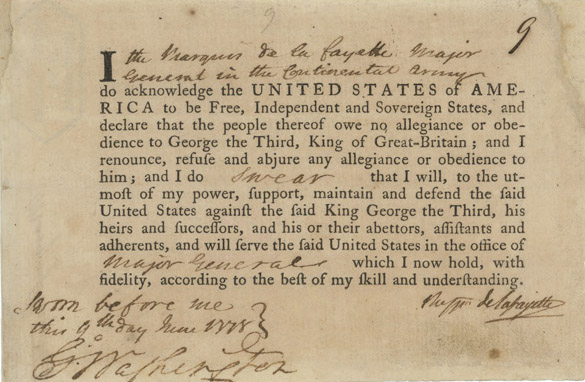Cur Non?/Why Not?

On June 13, 1777, the wealthy Frenchman Marie-Joseph Paul Roch Yves Gilbert du Motier, the Marquis de Lafayette, landed near Georgetown, South Carolina with the intention of aiding the fledgling United States in their war with Britain. As a 19-year-old immersed in the Enlightenment school of thought, he embraced his chosen motto of cur non (“why not”) and set out under threat of arrest by French King Louis XVI to support the American cause. Over the course of his life, he made four trips to America, each unique and noteworthy, cementing himself as one of the most famous figures in the history of our country.
In this issue
First Visit (1777): I’m here to learn…
After leaving South Carolina, Lafayette traveled to Philadelphia in the hope of joining George Washington in the Continental Army. His arrival was met with skepticism because of his youth and foreign status. However, due to his passion and sizable purse—he promised to serve without pay—he earned a commission as a major general.
General Washington and Lafayette quickly bonded, with Washington assuming a fatherly mentoring role after Lafayette declared, “I am here to learn, not to teach.” During his first combat mission at Brandywine, he bravely organized the retreat of troops even after he had been shot in the leg. Once he had recuperated, he returned to the field, soon joining Washington at Valley Forge in the winter of 1777-78.

Statue of Marquis de Lafayette
National Archives Identifier: 338958368
Second Visit (1780): Reinforcements
Lafayette returned to France in January 1779 to help secure additional troops and support from the French government. After a short, ceremonial eight-day jailing for having gone against King Louis XVI’s wishes, he was welcomed as a hero. He returned to the colonies in May 1780 and reunited with Washington. Now in charge of a division of troops, he led several patrol campaigns in New York and New Jersey. His patience was rewarded in early 1781 when he, along with Alexander Hamilton, led the siege of Yorktown against British General George Cornwallis. There, his strategic acumen helped trap the British forces, securing their surrender and ending the war.

Letter from Alexander Hamilton at Camp Before Yorktown,
Virginia to Marquis de Lafayette
National Archives Identifier: 44276763
Third Visit (1784): Here to teach
Lafayette traveled home to France after the war, but returned to America in 1784 to a hero’s welcome. During this trip, he visited the 13 independent states and reunited with George Washington at his Mount Vernon home. Ever the visionary, he addressed the Virginia House of Delegates, calling for “liberty of all mankind” and urging the emancipation of slaves. He also attended the Pennsylvania legislature and urged the new nation to form a federal union (the states were then bound by the Articles of Confederation). It was during this tour that he was officially made a citizen of Maryland, ensuring his national citizenship after the ratification of the U.S. Constitution.

Marquis de Lafayette’s Oath of Allegiance
National Archives Identifier: #4662573
Fourth Visit (1825): Farewell
Lafayette’s final and most celebrated visit occurred from 1824 to 1825, when he was invited by President James Monroe as part of the lead-up to the 50th anniversary of American independence. This Grand Tour was intended to last four months with visits once again to the 13 original states. Instead, he traveled the country for 16 months and visited all the 24 states of the union. The tour became a nationwide celebration in which cities competed against each other to show the extent of their gratitude for his impact on the country. This visit took him to Washington’s grave to pay his respects to his longtime mentor. It was also notable for his attendance at the laying of the cornerstone of the Bunker Hill Monument, where he gathered some soil to be sprinkled on his grave.

Lafayette House in Alexandria, Virginia
National Archives Identifier: 135805021
After he returned home, he died at age 76 on May 20, 1834. In the United States, President Jackson ordered that Lafayette receive the same memorial honors that had been bestowed on Washington, and both Houses of Congress were draped in black bunting for 30 days, with members wearing mourning badges.The Marquis de Lafayette had a lasting impact on the American spirit, shaped by his dedication to the principles of liberty and democracy. From his early defiance of his king to join the revolution to his final return aboard the USS Brandywine, named in honor of the battle where he was wounded, Lafayette’s unwavering support for American ideals left an indelible mark on the history of the United States.

Lafayette, Marquis de (bust)
National Archives Identifier: 512941




